A Paipo Interview with Javier Arteche
September 20, 2011 - San Sebastián (Donostia), Spain
E-mail interview by Bob Green
Before fiberglass boards became readily available in Spain, el txampero
(pronounced: "champ-ero") were ridden. These wooden bellyboards with turned up noses were popular
at coastal resorts like San Sebastián. With the availability of
fiberglass boards and boogie boards, interest in el txampero declined. Javier
recalls some of his experiences with el txampero. His older brother,
Iñaki, adds his recollections and the inspiration for his first making
a surfboard. As in other countries, the txampero is being revived and can be seen at surf festivals, as well as in the water.
|
1. My understanding is that
the political situation in the Basque country was still very difficult
in the 1950s. When I was in Donostia in 2011, there were hundreds of
people on the beaches. Was there much of a beach culture in Donostia in
the 1950s?
I was born in 1949, so I can tell very little about 1950. What I know
is that San Sebastián/Donostia has been a touristic city since the end
of the XIX century and that at the beginning of the XX century San
Sebastián lived its particular “Belle Epoque” as Queen Maria Cristina
used to settle in San Sebastián during the summer time.
There is a video on YouTube called, “Donostia San Sebastián (1920-1930),”
where images of La Concha beach totally crowded are shown. Amazing!! [See Note 1.]
I am not surprised that you say that when you were in San Sebastián
that there were hundreds of people on the beaches. Nowadays we cannot
understand life without the sea and maintain the same spirit and love
for the beach. All three San Sebastián beaches are crowded anytime
during the summer time.
Javier with the
last board he made in 2010 (left), and in 1970 (right).
|
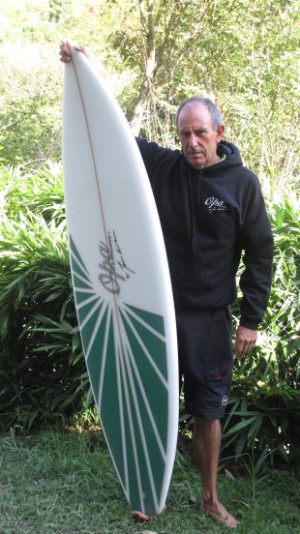
|
|
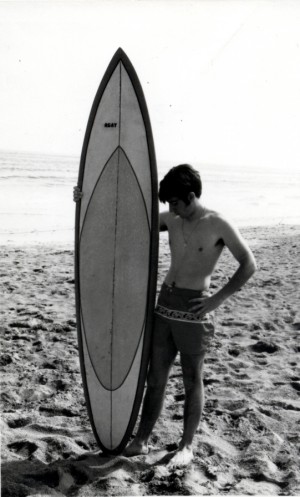
|
Photos courtesy of Javier Arteche.
2. What first attracted you to the surf?
My brother, Iñaki, was an avid snow skier and
thought surfing could be a nice alternative to snow during the summer
time. At that time, 1964, I was 14-years-old and used to accompany
him to “surf” in Zarautz, La Concha or La Zurriola. [See
Note 2.] We did not have any references so we learned and surfed on our own. As
time passed some traveling surfers that had come to surf in France,
came to Spain, and little by little we improved our surfing skills.
3. Before I ask about your experience with the txampero
can you explain the meaning of the word?
Etymologically, txampero comes from the Basque
word, txampa. "Take a txampa" means to take advantage of the strength and
movement of a wave, to ride it (it is also used in rowing, "the last
txampa"). Txampero would therefore mean the gadget that allows someone
to take a txampa.
4. Do you know if there were bellyboards or other
surfcraft before the laminated ply txampero?
Not to my knowledge.
5. When did you first see and ride a txampero? Whose
board was this and was it homemade or bought from a shop?
I do not remember exactly when I rode a txampero for the first time. We
were kids and txamperos where easy to find and not very expensive. I
was very fond of aquatic sports and spent hours on the beach, so I
imagine one day I asked my dad to buy one for me as they were an easy
and cheap way to keep children entertained.
A txampero purchased in San Sebastián in 1983, by Brian
Lowe.
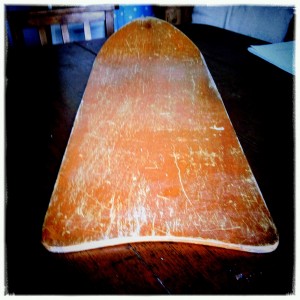
Photo courtesy of Traditional
Surfing UK.
6. Did you have your own txampero? What was it’s
dimensions and do you know who made it?
Yes, me and my brothers had our own txamperos. Dimensions were very
similar and around 4-foot long and 1-1/2 feet wide, with a rounded curled tip. No
idea of who the manufacturer was. [See Note 3.]
7. Did you use swim fins? What technique was used to get
out the back and catch waves if you didn’t use swim fins?
Sometimes we used fins to get waves out the back. In the case we did
not use fins our technique was not very sophisticated, as we used to
walk out the back and catch the wave just before it broke riding the
wave straight to shore.
8. Could you angle across unbroken waves or was the
txampero ridden straight to shore in whitewater?
We did not angle across unbroken waves and as I have said, we used to
ride straight to shore in whitewater, unless we used fins that allowed
as to catch the wave unbroken and "somehow" angle across.
As previously said our technique to ride the txampero was not very
sophisticated. We used to lean on the end of the txampero with our
belly, holding its tip with both hands.When we were not using fins we
pushed ourselves off the sand just before the wave broke and rode the
wave to shore, till we sank on the sand.
9. What conditions were most suited to the txampero and
where were they surfed in Spain?
We used the txampero mainly in La Concha (San Sebastián). Other places
such as La Zurriola were considered very risky and dangerous and we did
not go there. I am sure that txampero was used in many places along the
Spanish north shore, but I do not have any evidence of how the txampero were used.
10. What was the attraction of a txampero?
It was our way to enjoy the ocean. It was light and easy to transport
and you could take it anywhere you wanted. During September we gathered
at the beach to ride txampas for hours and hours. We really enjoyed it!
11. Did many people ride txampero? Were these tourists
or future surfers?
Yes a lot, mainly local kids and teenagers, very few tourists. Riding a
txampero was not a natural way to become a surfer. In fact, none of the
people that rode txampero with me became a surfer. The development of
surfing was very slow on our coast. I began surfing in 1964, when I was
14-years-old and in 1969, there were still only around 30 surfers in the
area.
12. Around what year did production and use of the
txampero decline?
I am afraid I cannot accurately respond to this. I would say that
during the 1980s, surfing began to take off and we could see the
first soft boards and the Morey Boogies on the beaches. These provided
other, more fulfilling sensations than the txampero on a wave. They
floated more and allowed the rider to be on his knees or to stand up.
Javier surfing at La Concha around 1966 to 1967.
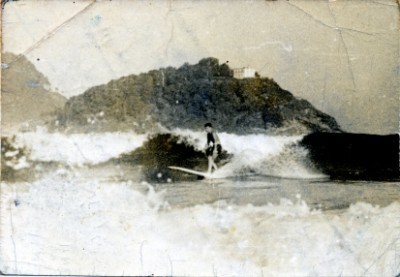
Photo courtesy of Javier Arteche.
13. Do you still see wooden txampero in the surf?
The txampero decline was very quick and to the point that you can hardly
see one txampero on our coast nowadays. I am sure kids would not know
how to use them now. I think that some romantics have tried to recover
the old txampero, but I do not think the initiative will have a lot of
success.
Txampero used as a skimboard by Pablo
Postigo, in 1979/1980. Javier Amezaga even recalled a person snowboarding with a
txampero tied with ropes to his boots.
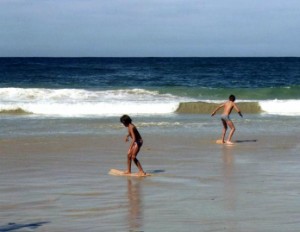
Photo by Pablo Postigo, courtesy of Cara B Gros.
14. I’ve read that the first fiberglass boards in
Donostia was made by the brothers Arteche. What is the story behind
these early boards?
My brother Iñaki, now 78-years-old, was the one that manufactured the
first fiberglass boards in Donostia. In 1964, when he first started,
there was little to no information about anything related to surfing in
Spain, and no surfboard could be found, so with the inspiration of a
Life magazine cover page, and some instructions he found somewhere else,
he made his own board. It was red, made of polyurethane, and was very
light. In fact, it was so light that he added coats and coats of resin
to get to the weight that apparently was the norm for a board.
It is amazing how Iñaki, without having seen a real board in his life,
and not knowing how they were made, developed techniques that were very
similar to the ones used to make a foam board nowadays.
The cover page of the Life magazine
that inspired Iñaki Arteche to make his first board.
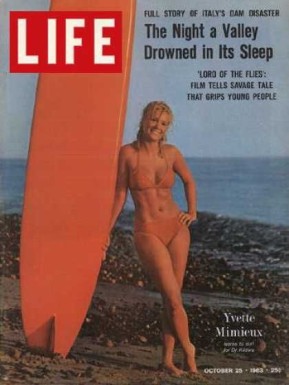
Figure courtesy of Javier Arteche, from Unknown photographer. (1963, October 25). Life magazine. Cover page photo of Yvette Mimieux.
In 1965, he started manufacturing surfboards which were sold to
some sport shops in San Sebastián. He stopped making them due to the
lack success and interest. He foresaw the future development of surfing
but as happens many times, he arrived too soon.
The 4 boards
Iñaki Arteche made in 1965, and Iñaki holding a board he made for Javier
in 1970.
|
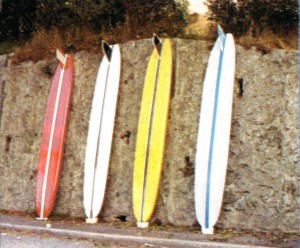
|
|
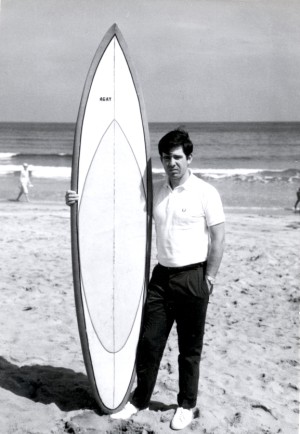
|
Photos courtesy of Javier Arteche.
The last surfboards he made were a couple of boards he made for me in
1970. Afterwards I subscribed to Surfer magazine and bought a booklet
called, How to make your own surfboard, and I continued Iñaki’s work
making boards on my own. I enjoyed making boards, but professionally I
took other routes, so I also quit making them. From time to time I
return to the shaping room and shape a board or two for the pleasure of
it.
Finalists of
the first Spanish contest held in Zarautz, in 1969. Javier (on the far
right) won the contest; Javier in a local contest, ca. 1970.
|
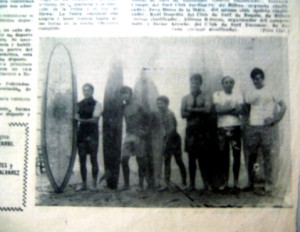
|
|
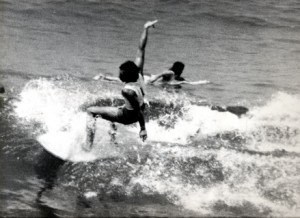
|
Figures courtesy of Javier Arteche.
15. Do you still get out into the surf? What are you
surfing these days?
Yes. I have been surfing non-stop during 48 years now. I do not surf
when it is above 8 to 10 feet but I love surfing and I enjoy it more than
ever. I am a sport enthusiast and go surfing nearly everyday, combining
surfing with other sports such as MTB, running, skiing and swimming.
Now I am riding a 6’7’’ Pukas "The Fang" round tail made by Peter Daniels.
It is a magic board, very lively and responsive.
Javier at
Zarauz (1970) and Gros (1972).
|
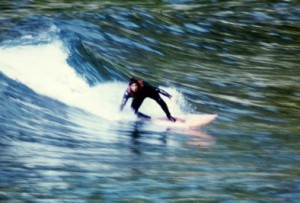
|
|
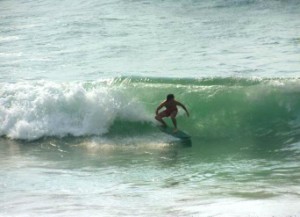
|
Photos courtesy of Javier Arteche.
Additional information from Iñaki Arteche (September 29,
2011).
During World War II, before the first
txamperos made their appearance in Zarautz beach, we as kids already used
to take txampas without txampero ( body surfing). In those same years,
I recalled having observed in a distant shot of a pirate movie (Captain
Blood (1935), starring Errol Flynn) how some people were standing-up
riding waves, on which I imagined were wooden boards. Some years later,
I could remember that diffuse image when I looked at a travel book in
which I saw a drawing of two salesmen on a boat while at its side, some
people enjoying themselves riding waves on very peaky long boards. From
them on, the dream of imitating them was always present on my mind.
"But... How to do it?" That was my problem until a very good friend of
mine that used to buy old books and magazines came to help me by
bringing a Reader's Digest issue in which had an article called,
"Jinetes sobre las olas" (September 1963, by Eugene Burdick). The author,
mentioned that surfing, the Hawaiian kings sport, was rapidly
developing in California, due to the fact that the old wooden boards
could now be made with resin and polyurethane/polystyrene foam that was
lighter and more shapeable than wood or cork.
And having a front page Life Magazine, in which a beautiful bikini
girl
appeared holding a huge board, as a model, I shaped two equally huge
polystyrene boards, 3 meter long, 55 cms wide and 15 cms thick, that
weighted 12 kgs. On a Sunday morning by the end of the summer of 1964, once I
had them finished, I took one of them, picked the 6:30 a.m. San
Sebastián- Zarautz train and there, on its famous beach, without any
references that could help me, or any other witness than myself, I
entered the water, enjoying the beautiful light of the sunrise, in
front of La Munoa."
|
Txampero were
also surfed in Santander and known as plankys. Here are Antonio Sáez
and Lolis at Sardinero, in 1961.
|
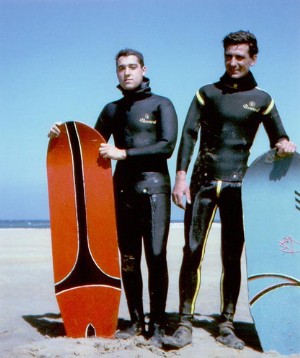
|
|
Regarding this photo Javier spoke to
his brother Iñaki Arteche. Javier writes,
"He has told me that the
first time he saw a txampero was in 1944-1945, in Zarautz, were he was
living at the time. The owner of the txampero was Javier Isturiz who
was the son of the notary of Zarautz. He has told me that nearly all
the youngsters at the small town of Zarautz rode and shared Javier's
txampero. The photo you have enclosed is interesting. I do not know
who the riders are but the txamperos look a very bit different to the
ones we used. Ours were not cut at the tail, they followed a straight
line from the tip, they were sort of rectangular. We also decorated and
personalized them."
Photo by "Meco" - Jose Manuel Gutierrez. Photo originally supplied by Sancho Rodriguez from Surfilmfestibal.
|
El txampero used as a promotional
tool by
Amstel, a beer marketed in Spain, in conjunction with the summer event series, The Amstel Surfari., Below are several photos
from the workshop of Carpinteria Azkuee, who built the boards.
Additional information appears in an article written for the Pensando en Blanco blog [see Note 4].
El txampero in
the workshop.
|
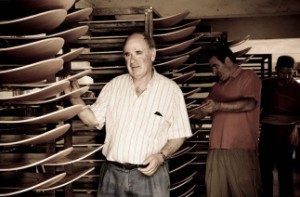
|
|
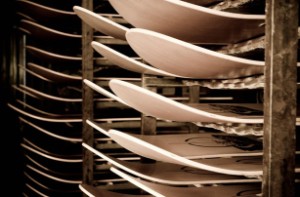
|
Photos ©
Surfilmfestibal.
In providing some history of the origination of these el txampero planks, Borja Garmendia
wrote:
"It wasn’t until last year, when we found a stock of these
classic planks at an old carpenter shop in the Basque Country. Of
course, the planks were piled
and forgotten in a dark corner at the far end of the workshop. After a
few seconds of nostalgia and laughs, remembering our little adventures
with this great device, we considered the possibility of recovering
them and bringing them back to life. Thus, we engraved the image of
Surf Film Festival on them, using them as part of our merchandising for
The Amstel Surfari,
a series of activities and events along the
Cantabrian coast sponsored by our main partner." Garmendia, Borja.
(2011, August 5). "El txampero - Amstel Surfari." [E-mail to B. Green].
Txampero
|
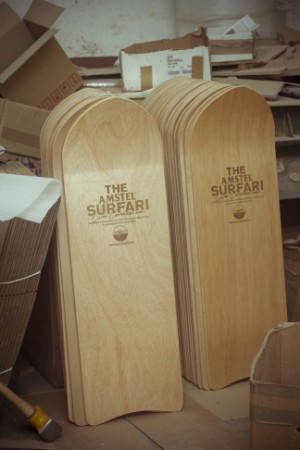
|
|
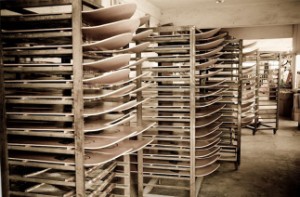
|
Photos © Roke by
Pensando en blanco and the Surfilmfestiba.
The txampero has
been featured on the surf festival program since 2009. See
http://www.surfilmfestibal.com/2009/EN/web09/venues.html and
http://stafmagazine.com/events/amstel-cosmic-children-festival/.
Txampero continue to be built from the workshop of Carpinteria Azkuee.
Borja in the
Azukee workshop.
|
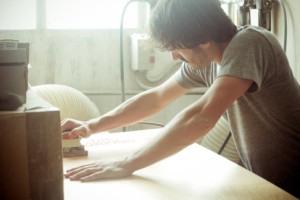
|
|
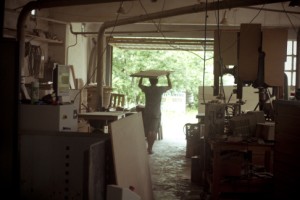
|
Photos © Roke by
Pensando en Blanco.
Note 1: See the YouTube video,
Donostia San Sebastián (1920-1930), at http://youtu.be/S17iH7S_bE0, uploaded by TxuriUrdintxo on Jun 17, 2010.
Note 2: The website, Cara B Gros, contains more photographs of the Arteche brothers and San Sebastián
surfing culture, especially 1970-1979. There are also audio-interviews
with the Arteche brothers and others. This site is the work of Alain
Gonfaus Martinena and Juan Aizpitarte. Click on www.carabgros.com to visit the website.
Note 3:
Two manufacturers of el txampero have
been identified. The boards and press of Marcelo Linazasoro, who began
building bellyboards after a trip to Biarritz in the early 1950s, have
been documented in the 2007 book, What the waves brought in a history of surfing in Zarautz (English version). See the entries in Basque (Euskara), English, and Spanish:
- Echegaray Eizaguirre, Lázaro and Mikel Troitiño Berasategi. 2007. Olatuek ekarri dutena: Zarauzko surfaren istorio bat. Zarautz: Udala, Kultura Saila;
- Echegaray Eizaguirre, Lázaro and Mikel
Troitiño Berasategi. 2007. What the waves brought in a history of surfing in Zarautz. Zarautz: Ayuntamiento, Departamento de Cultura; and
- Echegaray Eizaguirre, Lázaro and Mikel
Troitiño Berasategi. 2007. Lo que han traído las olas: una historia de surf en Zarautz. Zarautz: Ayuntamiento, Departamento de Cultura.
Note 4: Blog spot, Pensando en Blanco, published an article on the txampero, in 2010. See the article: Garmendia, Borja. (2010, March 18). El Txampero, el autentico precursor del deslizamiento en nuestras costas. Pájaros Online publication of Pensando en blanco. Retrieved February 13, 2012, from http://www.pensandoenblanco.com/.
Acknowledgments: The assistance of Alain Gonfaus Martinena and Zuberoa
Andrés was much appreciated.
|
|